Whether you’re interested in international marketing, or just want to learn more about how audiences around the world interact with the internet, learning about the top global platforms can be an eye-opening experience.
Below, you’ll explore 17 of the most popular social media platforms around the globe, including TikTok’s origin platform — Douyin.
The 17 Biggest Global Social Media Platforms
1. QZone and QQ
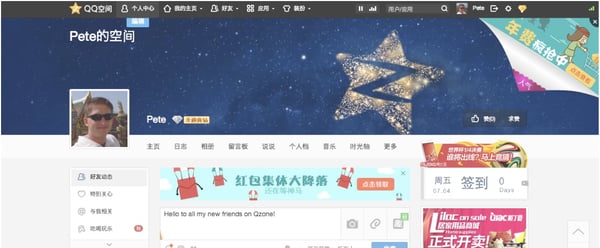
- Owner: Tencent
- Origin: China (Available globally, Chinese language-only)
- Name’s Origin: QZone and QQ were shortened from the original name, OICQ. The O stood for “open” while ICQ is an instant message term that sounds like “I Seek You” when said allowed.
- Reported Users: Over 600 million active users on QZone with 574.4 million monthly users on QQ.
QZone is a social media channel while QQ is a messaging app that links to a QZone account. The two apps serve as an alternative to Facebook in countries like China and South Korea, where the U.S. platform is blocked.
The platform’s story began in 1999 when QQ launched as a desktop messaging site. QZone, a social media site and app, launched in 2005.
In 2019, as mobile-first mindsets grew, Tencent transformed the QQ website into a standalone app. QZone still serves as a social media platform while QQ is now similar to the Facebook Messenger app.
To help you better visualize how people have used QQ and QZone, here’s a quick analogy: When U.S. millennials were children, we raced home from school to message our friends on AIM.
Then, as we reached high school, we ventured onto Facebook, where we could message people, create a profile, and post updates.
Meanwhile, in China, people in my age group might have messaged friends on QQ’s messaging website instead of AIM. Now, QQ users might use its sister app — QZone — for a social media experience that’s comparable to Facebook. Then, to message friends, they use QQ.
On QZone today, users are encouraged to publish posts, videos, or even music. Like Facebook, they can also connect with friends, see a feed of updates, comment, share or react to posts, and update cover or profile photos.
The QQ and QZone are great examples of social brands that gained traction long before platforms owned by U.S. tech firms. QQ and QZone users are so strong in China likely because young audiences adopted its messaging tool and were able to enjoy its full social network later on.
Although Facebook launched 2004, one year before QZone came out, Tencent had already captured the millennial demographic with QQ, figured out how to grow its product competitively with QZone, and continued to add features to pull in Gen Z audiences.
While QZone and QQ seem like Facebook alternatives, their history of growth is fairly parallel. And, as one of the biggest social media platforms globally, QQ is worth knowing about if you plan to market in Asian territories with heavy censorship.
2. WeChat/Weixin
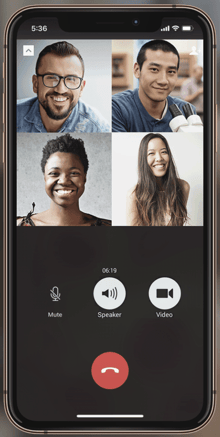
- Owner: Tencent
- Origin: China (Available globally)
- Name’s Origin: The app’s original name was Weixin, which translates to “micro letters.” In a play to become a more globally used app, Weixin rebranded to WeChat in 2012.
- Reported Users: 1.29 billion active users
WeChat launched in 2011, before competitors like Kik and WhatsApp. The messaging app was rolled out by Tencent, which also created QZone and QQ.
Similarly to WhatsApp, WeChat allows free, text-based chats and voice calls. It also has a “Moments” feature similar to Instagram or Facebook Stories. Like many U.S. platforms, you can place fun animated stickers on images or videos sent within the app.
To join WeChat, users need to know someone on the platform and have them scan an activation code that a user receives when logging in for the first time. Then, they can access WeChat’s messaging feature, send videos to friends, and host virtual phone calls.
Aside from using the platform for friend-to-friend communication, users can also take advantage of more entertaining features.
For example, while one feature allows people to play in-app games live against friends, others include filters that can be used in chats or video calls.
WeChat also connects to a number of third-party or Tencent-owned apps so that a user can take on multiple tasks. You can hail a ride or pay friends money, directly from WeChat.

At this point, Facebook, Snapchat, WhatsApp, and other major apps are using a similar strategy, pulling additional features into their platforms to keep users logged in longer.
For example, many top messengers allow group video calls, offer in-app games, or let users send money.
3. Weibo (Sina Weibo)
- Owner: Sina Corp.
- Origin: China (Available globally with text in Chinese.)
- Platform Name Translation: Loosely translates “microblogging.”
- Reported Users: 584 million monthly active users
Weibo, also called Sina Weibo, is the biggest Chinese microblogging and social media platform. The social channel made news in 2017 when it reached more monthly active users than Twitter.
Since then the app’s continued to grow. Reports suggest that more than 30% of Chinese internet users now have an account on the platform.
When you visit the website, it’s automatically in Chinese. However, you can use Google Chrome’s translator to convert the text to different languages.
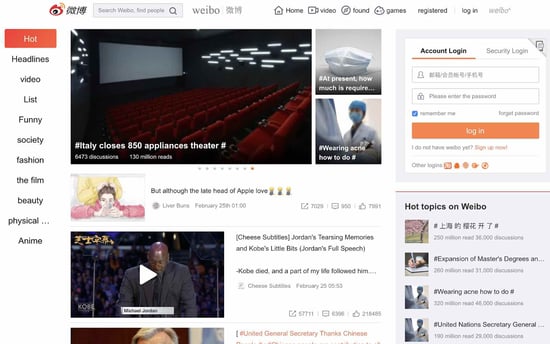
Like Twitter, Weibo offers a central feed where you can see the latest or highest-performing posts. To toggle through different types of posts, you can click a category on the list in the left sidebar.
On the right, you can see “Hot Topics” similar to Twitter’s “Trending Topics.” If you continue to scroll down, you’ll also see a box that allows you to search for people.
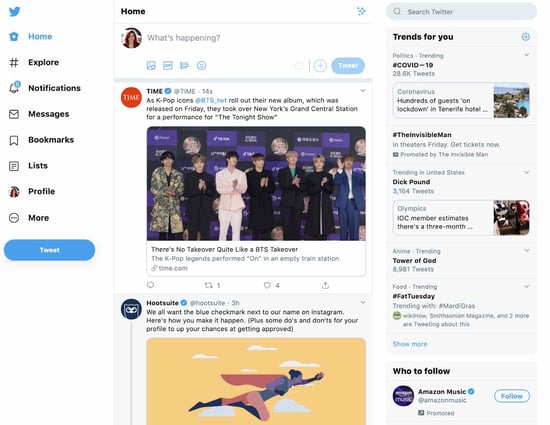
While Weibo’s layout and microblogging mission are similar to Twitter’s, the Chinese platform emphasizes videos, photos, and trending content, while Twitter still puts an emphasis on the accounts sharing the content.
Although Twitter also prioritizes trending content, you can easily see which of your followers posted, liked, or retweeted it before seeing the content in a tweet.
This allows audiences to subconsciously focus on the person who tweeted something as well as the tweet itself.
These slightly different layouts might also suggest that the audiences of each platform prefer to consume content differently. While Twitter’s audience might prefer the human connection, those on Weibo might want to jump straight to the content.
4. Douyin
- Owner: ByteDance
- Origin Country: China (Available only in China; TikTok is available globally)
- Name’s Origin: Douyin loosely translates to “shaking sound” or “vibrato.”
- Reported Number of Users: 613 million active users
Douyin is the Chinese-only counterpart to TikTok, which is owned by the same company. TikTok specifically is a merger of Douyin and the Musical.ly lip-syncing app. Both social media apps specialize in allowing users to create, edit, and share short-form vertical video.
After Douyin launched in early 2018, it grew to 150 million active users in year one. ByteDance then purchased a similar lip-syncing app called Musical.ly and created TikTok, a global app that merged the best features from each platform.
Since launching in late 2018, TikTok’s also seen viral growth by gaining roughly 1.2 billion active users. Like Douyin, TikTok also sees a large number of international influencers from countries like India.
While Douyin and TikTok are very similar short-video apps and are often confused as the same thing, they have a slightly different sets of features, are powered by different servers, and have different levels of censorship due to regulations around the world.
Douyin isn’t accessible for us to preview in the U.S., but news outlets describe it as being even more advanced than TikTok — particularly when it comes to ecommerce.
For example, while TikTok rolled out advertising options in 2020, Douyin already allowed users to triple-tap a video with a product featured in it to go to a brand’s ecommerce store. Users can also use the app for virtual tours of hotels, stores, or travel locations.
Douyin also reportedly allows users to geotag themselves at a store or location. This could be helpful for providing brand awareness to local brands.
When it comes to what Douyin and TikTok have in common, both are apps where users can share short videos that can feature musical overlays, fun filters, and text.
From photos I’ve dug up online, it looks like the platform’s design is very similar with some slight design differences. The screenshots below show a video ad and the platform’s search feature:
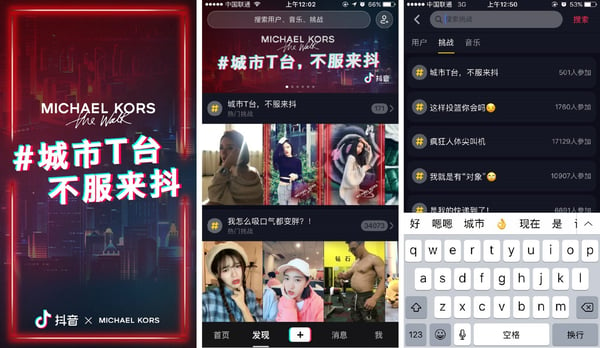
As a comparison, here’s what a video ad and the search feature look like on TikTok.
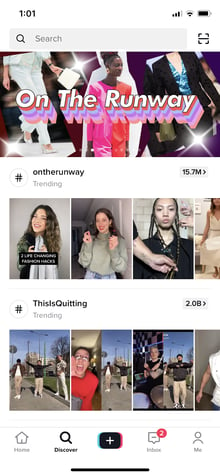
Both apps are also centered around a feed that algorithmically shows users videos from followers or videos that they might enjoy based on previous content they’ve viewed.
When users enter the app and see the feed, one video will begin playing automatically. To see other videos, users simply swipe up on that feed. Here’s what this looks like on TikTok:

Aside from the shared features, both fast-paced social media channels are favored by younger generations. While over 92.39% of TikTok’s audience is younger than 34, it’s also been reported that Gen Z has flocked to Douyin.
Douyin and TikTok’s success story is a great example of how one unique international platform can change the way we consume content in other countries. Prior to TikTok’s launch in the Western hemisphere, many Americans hadn’t seen anything similar to it since Vine.
Not only did Douyin and TikTok replace the need for Vine, but both apps also catered to Gen-Z and millennials, two mobile-first generations known for short online attention spans and heavy consumption of video content.
5. Kuaishou
- Owner: Kuaishou Technologies
- Country of Origin: China
- Name Origin: No translation could be found.
- Number of users: 308.2 million daily active users
Kuaishou is a short-video app that competes with Douyin. This platform started as a GIF-sharing site called Kuaishou GIF. It was like GIPHY in the sense that anyone could create, post, and share GIFs on the network.
In 2012, Kuaishou dropped GIF from its name and pivoted to a short video platform. Its interface is now very similar to Instagram’s.
Kuaishou doesn’t have a “Stories” feature like Instagram, but it features similarly looking profiles and feeds where users share short vertical videos rather than photos or other content.

Like Douyin or TikTok, the video features of Kuaishou seem fairly similar in that users can leverage sound bites and basic editing tools in their content.
Like many social media platforms with videos, Kuaishou also allows users to overlay text and stickers on images or videos.

From looking at a variety of videos that have been uploaded to other sites from this platform, it seems like many users have used this app to highlight their unique skills and musical talent.
A number of users have also shared videos that highlight and celebrate aspects of rural China.
In 2019, Apple distinguished Kuaishou as a global app that was defining mobile video storytelling trends. This came shortly after the app notably added ecommerce and monetization features that enabled creators in poverty-stricken rural China to make money from it.
Aside from its short videos, Kuaishou also allows users to live stream content on the platform. Similar to the short video feature, the stream has allowed users to film longer videos that highlight their skills.
6. VKontakte (VK)
- Owner: Mail.Ru Group
- Country of Origin: Russia
- Name’s English Translation: VKontakte loosely translates to “in contact with.”
- Reported Number of Users: 67 million users
VK, the biggest social channel in Russia, is like a mix between Facebook, YouTube, and the 90s illegal downloading service LimeWire. This platform allows users to publish and share text-based posts, photos, video files, and music files with their connections.
When it comes to this platform’s user interface, it looks eerily similar to Facebook, with some slight tweaks to page layouts.

Aside from allowing users to share their own content, they can allegedly upload and stream copyrighted material, such as music and movies. This has allegedly been abundant on the platform since its launch, but legal steps have not been taken against it.
The social platform is owned by Mail.Ru Group, a tech company that owns Russia’s main search engines and OK.RU, a social platform noted below. Reports also suggest that this company has affiliations with the Russian government.
Surprisingly, the majority of VK users are between the ages of 25 and 34.
This popularity could be due to multiple reasons, including the platform’s ability to allow users to share audio and video files between friends. The platform also encourages users to expand their social circles and not limit themselves to the ones they’re already in.
7. Odnoklassniki (OK.RU)
- Owner: Mail.Ru Group
- Country of Origin: Russia
- Name’s English Translation: Odnoklassniki translates to “classmate.”
- Reported Number of Users: 33.8 monthly active users
Odnoklassniki, or OK.RU, is a website that specializes in connecting people with their past classmates. The social media platform is set up like a blog, similar to Tumblr, where users can share life updates, images, or videos, which then show up in other users’ home page feeds.
Along with their classmates’ content, a sidebar shows users the most popular videos that have been posted on the platform.
Below is a look at the feed. While the site is in Russian, I’ve used Google Chrome to translate it so you can get a better idea of what people are posting.
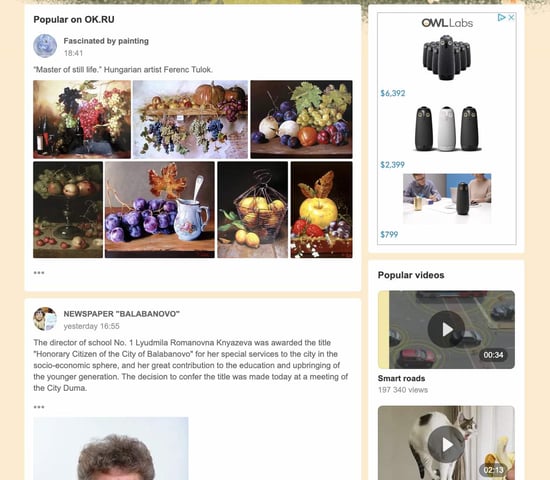
Like Tumblr, users can also click on the name or image of another user in a post to find that person’s profile.
These profiles are similar to Facebook’s layout in that they show a cover photo, a user’s top followers (called “participants”), and then a feed of their own content.

While this platform is similar to both Tumblr and Facebook, Russian citizens don’t commonly use those two platforms as much as OK.RU.
Additionally, with warnings that Facebook, YouTube, and Instagram could be banned in Russia, it’s not shocking that tech companies in this region have innovated to create similar alternative platforms.
As we’ve seen with the Chinese platforms above, many global platforms have been inspired by or created as an alternative to U.S.-based sites that were censored or banned.
These continent-specific platforms could be a theme we continue seeing in different areas of the world.
If you’re an international marketer, it can be helpful to identify segments of your audience that might not be able to access the platforms you use for social media marketing. Then, research any alternatives that you can access to promote your content in those locations.
8. Telegram
- Owner: Telegram Group Inc.
- Origin: UAE
- Name’s Origin: Named after the telegram system, coined by Charles Wheatstone in 1834.
- Reported Users: 700 million monthly active users
Telegram is a cloud-based messaging platform founded in 2013 by Nikolai and Pavel Durov, who also previously founded VK. Known for its end-to-end encryption and focus on privacy, Telegram tends to grow in popularity every time another app experiences a security breach.
The app was launched as an alternative to WhatsApp when the latter announced it would share user information with its parent company, Meta. As it serves as a secure alternative to WhatsApp, Telegram’s interface looks quite similar to the one we’re used to.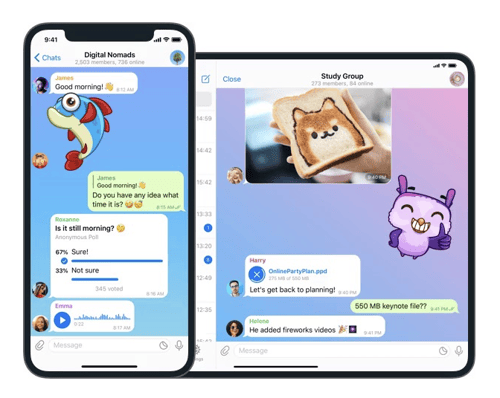
At first glance, you might not be able to tell the difference between WhatsApp and Telegram because they look very similar in their basic text messaging capabilities.
But Telegram takes WhatsApp’s features up a notch with chat folders that help you organize conversations, open API that allows you to build your own Telegram clients, and no sim sign-up to protect your phone number from public view.
Open API also enables you to create Telegram Bots that automate tasks and respond to user messages.
What’s also interesting about Telegram is its “Secret Chat” feature which allows users to send messages set to self-destruct after a certain period and leave no trace on its servers.
The app also allows you to create chat channels with up to 200,000 members, compared to WhatsApp’s current 1,024, and lets you send media with no limits on size or type.
Previously completely free, Telegram launched its Premium tier in 2022. Features such as voice-to-text, doubled limits on channels, chat folders, chats, unique stickers and reactions are available for you to explore on Telegram Premium.
Telegram currently has 70 million active users in India, 24 million in Russia, 19 million in Indonesia, and 18 million in Brazil. The app also allows sponsored ads in some regions, so it’s worth exploring if you’re interested in expanding your presence in these countries.
9. LIKEE
- Owner: JOYY Inc.
- Origin: China
- Name’s Origin: Previously named Like, the founders changed the name in 2019 and added an extra “e” to convey the additional value it offered after it was redesigned and rebranded.
- Reported Users: 150 million monthly active users
TikTok’s rise to fame may have been meteoric, but it’s not the only video-sharing social media platform on the block. Singapore-based Bigo Technologies (owned by JOYY Inc.) launched LIKEE in 2017 as a competitor to TikTok.
LIKEE is a short video-sharing platform that’s gained huge traction since its launch. It focuses on content from young users and celebrities who use the hashtag challenge feature to create viral videos for the app.
Like TikTok, the app features an AI-powered algorithm that recommends content relevant to each user’s interests. LIKEE also has filters, special effects, and tools to help users create content.
In 2018, LIKEE was one of 59 Chinese apps banned in India due to the rising tensions between the two countries. Before this, India was the biggest market for LIKEE, where it was available in 15 Indian languages, including Hindi, Tamil, Bengali, Marathi, and Telugu.
LIKEE seems pretty similar to TikTok on the surface, but what sets it apart is its creator monetization tools.
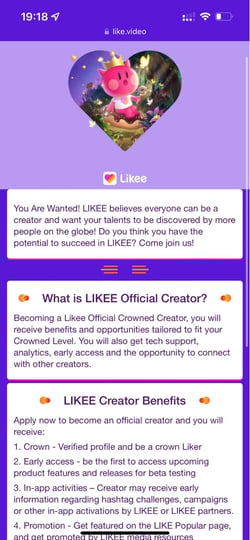
The LIKEE Official Creator program, for example, gives creators access to different benefits, such as invites to exclusive events and promotions on the LIKEE popular page based on their “crown” level.
The app also focuses on live streaming. LIKEE creates a more immersive live streaming experience by allowing creators to create personalized 3D avatars of themselves and allowing them to create and join online communities.

While TikTok is still leading the charge as the most popular short-video-sharing platform, LIKEE is slowly gaining ground and may just be the next big thing.
10. LINE
- Owner: Line Corporation
- Origin: South Korea
- Name’s Origin: No origin could be found.
- Reported Users: 182 million monthly active users
If there’s a powerhouse app that seems to be doing everything, it’s LINE.
The South Korean messaging app was launched as a response to the 2011 Tōhoku earthquake and tsunami to help users communicate with each other despite network outages.
It quickly gained traction, becoming one of the biggest messaging tools in Asia.
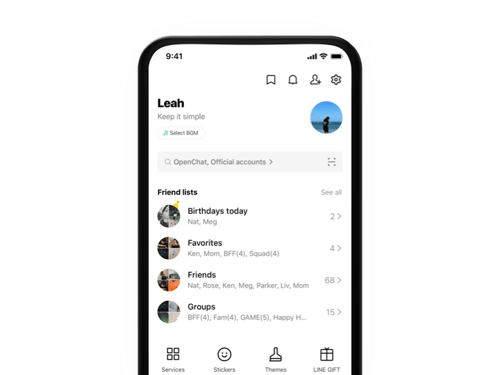
The messaging tool integrates with a suite of services ranging from payments with LINE Pay, telemedicine with LINE Doctor, and music streaming with LINE Music.
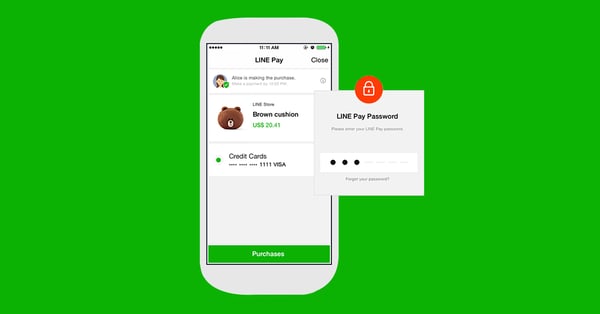
The app’s stickers are their own cultural phenomenon. They’re so popular that you can actually buy real-life merchandise of them on the LINE Friends Store.
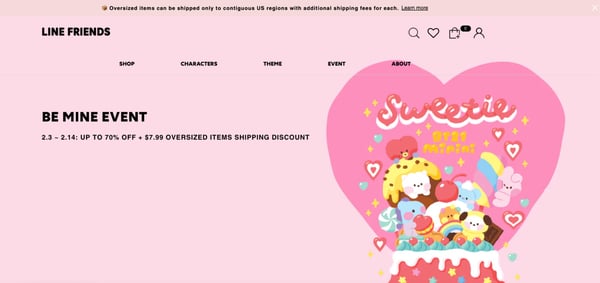
The Creators Market also provides users with a platform to monetize their sticker creations and sell them on the LINE Sticker Shop, LINE Theme Shop, and LINE STORE.
LINE’s primary website is in English. Many of its subsidiary websites, including LINE for Business and LINE News, are in Japanese.
LINE’s integration with other aspects of its ecosystem is a great way for businesses to reach new audiences and build loyalty with existing ones.
It also eliminates the need for users to switch between an array of apps, creating a streamlined experience and reducing distractions.
11. Douban
- Owner: Beijing Douwang Technology Co., Ltd.
- Origin: China
- Name’s Origin: Named after a hutong, or narrow lane, in Beijing. The literal translation of Douban is “an embryonic leaf.”
- Reported Users: 300 million users
Douban is a popular social networking platform originating in China. It was created by Yang Bo in 2005 and has since grown to be one of the largest online social networks in the country.
The platform allows users to communicate, share their interests, and rate films, books, music, and other content. On Douban, users can follow each other, create a profile, post and comment on discussion boards, discover new content, and get recommendations.
Douban is available in Chinese, but here’s a translated preview of its homepage.
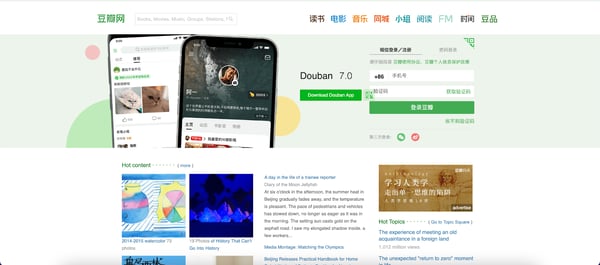
Dubbed the “Chinese version of IMDb” due to its focus on movies and film reviews, Douban is also known for being one of the few Chinese social networks that allows political discussions, although censorship is still enforced.
The platform hosts many events and activities, such as meetups, lectures, film screenings, and festivals. It also has an online radio station called Radio Douban which allows users to tune in and listen to music from different sources.
Douban boasts a lively online community for young and educated Chinese users engaged in literary and film discussions. It’s also proven popular among young people as it allows them to express their views, stay connected, and discover new content.

In 2022, the app tightened its policies and now requires overseas users to register with a mainland mobile phone number or official identity document to continue using the platform. In short, anyone who wants to use Douban must prove their identity.
Beijing’s increasing censorship may be tricky to navigate for brands trying to tap into this educated and affluent demographic, yet it’s still possible to have success on Douban if done right.
12. Baidu Tieba
- Owner: Baidu
- Origin: China
- Name’s Origin: Baidu Tieba — the word Tieba is simply the pronunciation of the Chinese word “贴吧”, a made-up word that translates to “Let’s Post.” The word Tieba has its meaning extended to the word “forum” or “group” as well.
- Reported Users: 45 million monthly active users
Tieba is one of the largest Chinese discussion forum networks. The parent company, Baidu, also owns one of the biggest search engines in the world, with 3.3 billion searches per day. Established in 2003, Tieba is a forum-style interactive community where users can share content and discuss topics of common interest.
Tieba offers a wide range of features for users, such as customizable avatars, special effects, and tools to help you customize your posts. There are also an extensive array of filters that allow you to search for posts by keywords or tags.
Every Tieba, or individual community, has its primary coordinator, usually referred to as the “administrator” or the “moderator” in English. This coordinator is responsible for keeping the forum safe and orderly.
Tieba’s user-generated, content-driven nature makes it an ideal platform for businesses to engage with their customers, build relationships, and find out what their customers think.
The platform uses two aspects — experience points and account level — to assess the quality of its users. The more you engage on the platform and interact with other users, the higher the account level and the more experience points you’ll gain.
Baidu Tieba had accumulated over 300 million monthly active users, and its registered users skyrocketed to 1.5 billion by 2015.
By 2021, however, the Reddit-style platform lost 90% of its users due to issues such as lack of management and excessive commercialization. With 45 million active users, it still has considerable potential to establish itself as a major player in the market.
The website is in Chinese, and you’ll have to use Google’s translate feature to access its content.
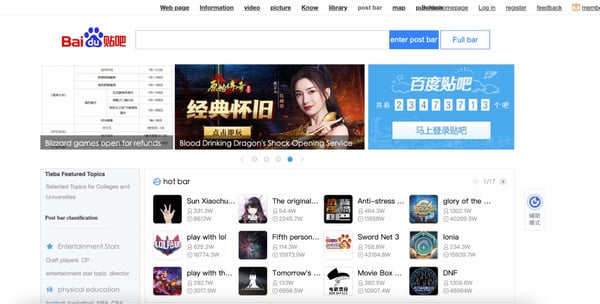
The central feed displays hot topics and discussions. Users can scroll through these topics to find relevant information, join in on existing conversations, or create new ones.
The feed also displays news at the top, which you can click on to stay updated with recent events.
13. BeReal
- Owner: Alexis Barreyat and Kevin Perreau
- Origin: France
- Name’s Origin: The name relates to its focus on users uploading unpolished photos.
- Reported Users: 73.5 million monthly active users
BeReal, a French anti-influencer social media app launched in 2020, only allows users to post pictures and videos that are unedited and unfiltered to promote “authenticity.” The app discourages users from curating a version of themselves that’s impossible to attain.
BeReal notifies users to take a picture in two minutes using their front and back cameras simultaneously with a location and optional caption.
While other users can’t like or dislike a post, they can comment. You can also react to posts with a “RealMoji,” which is a picture of your own face.
The app is most popular in the U.S., followed by France and the U.K. BeReal’s monthly active users increased by more than 300% in 2022.
Gen Z, currently the largest generation on Earth, seems to have a liking for BeReal’s more realistic approach.

In a recent article, Meredith Mueller, a sophomore at the University of Kansas, highlights how, unlike Instagram or Snapchat, BeReal offers a pressure-free experience.
“Snapchat is more like you’re sending this to one person, if you post on your story, you’re trying to look good,” she said. “Whereas this is like … wherever you’re at, whatever you’re doing, you stop in the moment and all your friends can see it. It’s more like a down-to-earth app. I would say it’s like a judgment-free zone.”
BeReal currently doesn’t offer any advertising or monetization opportunities for brands. Brands like e.l.f. Cosmetics and Chipotle launched brand accounts last year and built followings with discount codes.
Still, with the app’s spontaneous nature and BeReal’s determination to maintain its philosophy of authenticity, it would be interesting to see how brands adopt it.
What’s clear is that Gen Z loves this authenticity, and brands must be innovative to create a presence on the platform.
14. Moj
- Owner: Mohalla Tech
- Origin: India
- Name’s Origin: The name is a spin on the Hindi word “mauj,” which means entertainment.
- Reported Users: 120 million monthly active users
Thirty hours after India banned 59 Chinese apps due to ongoing tensions with China on June 29, 2020, the Indian social media platform ShareChat launched Moj.
The app was designed to replicate TikTok, thus offering a similar user experience with features, such as 15-second videos and special effects. Within three days of its launch, Moj amassed 50,000 downloads.
India, the country with the largest population in the world, has 22 official languages. Moj supports over 15 languages, including English, Bengali, Hindi, Gujarati, Kannada, and Malayalam.
Like TikTok, users can lip sync, create digital art, and use AI-powered effects. The app also features interest-based content recommendations and live streaming.
Since Moj is a TikTok replica, its interface looks almost the same as TikTok. It has a home page, which displays trending and recent videos, and also allows users to browse content in different categories.

Users can browse the app without having to register. To start creating and sharing content, however, they must sign up with their phone number or Facebook account.
“Moj for Creators,” a program launched in April 2022, aims to help creators earn Rs 3,500 crore by 2025 with new monetizable features.
These features include performance-based weekly rewards, brand collaborations, creator courses, an exclusive creator club, and a dedicated creator manager to help creators grow.
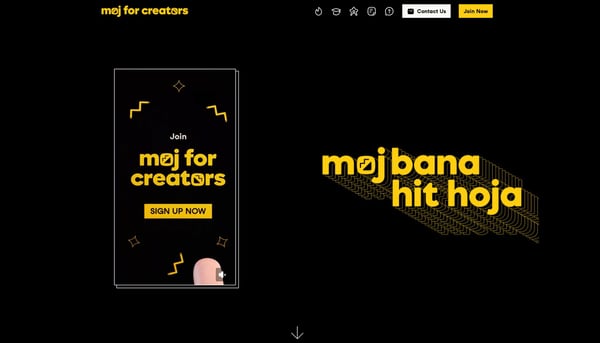
Aside from this, Moj Live also allows users to earn money and rewards by live streaming their content. Creators can engage with their audience in real-time and send virtual gifts.
Despite its efforts, Indian creators think local alternatives like Moj come nowhere close to the level of recognition that TikTok offered.
Nevertheless, Moj has gained immense popularity in India and offers global businesses a gateway to a diverse and fast-growing market.
15. Xiaohongshu
- Owner: Xingyin Information Technology
- Origin: China
- Name’s Origin: Xiaohongshu translates to “Little Red Book.”
- Reported Users: 158 million monthly active users
The Chinese answer to Instagram, Xiaohongshu (also known as Little Red Book or RED) is a content-driven, ecommerce platform that connects local and international Chinese consumers to brands.
Xiaohongshu was created by Miranda Qu and Charlwin Mao in 2013 and has since become a leader in the user-generated content (UGC) space.
When it first launched, WeChat and Weibo dominated the Chinese social media landscape. Xiaohongshu tapped into the young Chinese urban women’s market by providing a platform for them to read product reviews, share user experiences, and discover new products.
The app currently focuses on beauty, fashion, lifestyle, and travel. Today, 70% of its user base are women.
RED’s focus on products and shopping makes it popular among the Chinese elite. Chinese shoppers will make up 40% of all luxury consumers by 2030. The app taps into the buying power of affluent Chinese millennials and provides valuable insights into their shopping habits.
Xiaohongshu’s main feed has three tabs: Follow, Explore, and Nearby. Even though the app is similar to Instagram, its “Nearby” feature is unique and allows users to discover new places, products, and trends around their location.
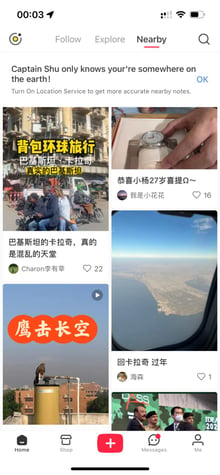
The app’s post tool also offers more editing features than Instagram, including beautify.
The Explore tab includes categories such as weight loss, manicures, cosmetics, mother-baby, and emotion, showing how RED uses traditionally female-focused topics to create engaging content.
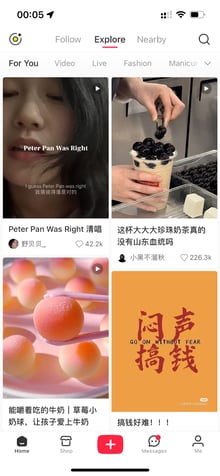
Xiaohongshu allows brands to have their storefronts on the app, which users can access to find out more about the brand and purchase their products.
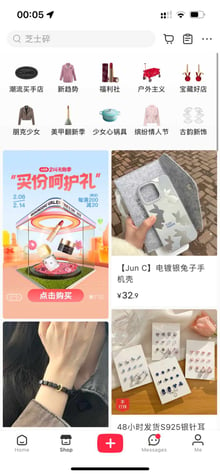
RED’s focus on a niche female demographic, ecommerce capabilities, and unique content make it a valuable platform for brands looking to reach the Chinese market.
Brands can partner with local influencers to spread awareness, sell products, and engage with the audience.
16. Yubo
- Owner: TWELVE APP
- Origin: France
- Name’s Origin: The app was previously named Yellow and it has since rebranded to Yubo.
- Reported Users: 60 million users
Another French social media app that’s rising in popularity among Gen Z is Yubo. Launched in 2015 by Sacha Lazimi, Jérémie Aouate, and Arthur Patora, the app aims to create a space for young people to meet new friends and find their community.
Yubo, formerly known as Yellow, was created with an emphasis on safety, openness, and inclusiveness. The app is aimed at teenagers and encourages users to create groups, share photos and videos, chat with friends, play games, and even live stream.
For some time, Yubo was known as the “Tinder for Teens” due to its swipe-based interface. Users can choose who they want to connect with based on their interests and profiles.
The platform attempts to keep its younger and older users separate with two disconnected communities — one for young people aged 13 to 17 and an adult community for people aged 18 and above.
Separate communities prevent users in one community from interacting with users in the other community.
In the past, Yubo faced backlash due to its security issues, including the ability of adults to create and use fake accounts.
However, Yubo has since implemented measures such as partnering with digital identity provider Yoti to help vet suspicious users and manage ID verification. In 2022, Yubo also rolled out age “estimating” technology to better identify minors.
Users can use the in-app currency, YuBucks, to make purchases, such as adding an extra number of new friends or boosting their profile to get more visibility. Yubo also features ads, which users can opt to skip or watch in exchange for YuBucks.
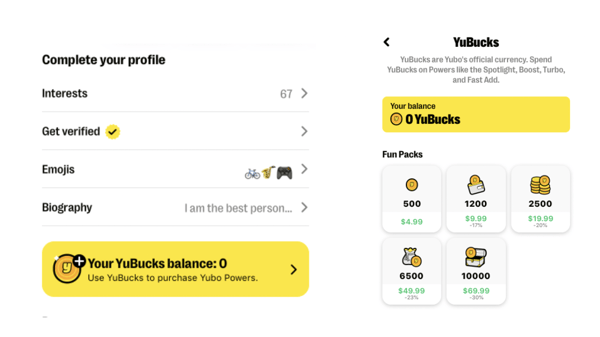
Yubo has a partnership with Snapchat revolving around the Snapchat Camera Kit, which allows the platform and its creators to use Snapchat’s filter system and features. Yubo also creates game filters you can play with, like on Snapchat.

17. Rakuten Viber
- Owner: Rakuten
- Origin: Israel
- Name’s Origin: No origin was found.
- Reported Users: 260 million monthly active users
Viber is a free messaging and calling app created in 2010 by two Israeli brothers, Talmon Marco and Igor Megzinik.
Viber quickly gained popularity due to its intuitive interface, seamless syncing across devices, encryption, HD audio and video calls, and an extensive array of stickers.
In 2014, Rakuten, the world’s third-largest ecommerce company acquired Viber for $900 million.
Since then, the app has made significant improvements, such as introducing video and voice messaging, payments, games, and even its own currency called “Vibes.”
The platform has users in 190 countries, and its registered users have surpassed 260 million monthly active users. Here’s a preview of Viber’s feed.
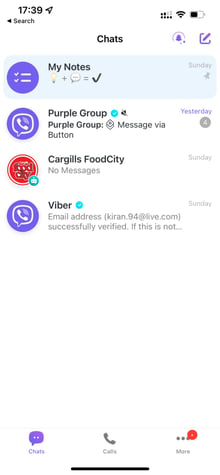
As you can see, you also have a “My Notes” tab that allows you to write notes and memos.
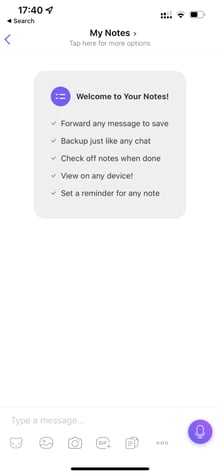
Viber also has an extensive array of features that make it great for business use. It provides collaboration tools such as polls, surveys, and document sharing, among others.
Viber Business offers a range of tools to help companies reach their customers, such as allowing transactions, offering real-time customer support, and sending relevant messages and promotions.
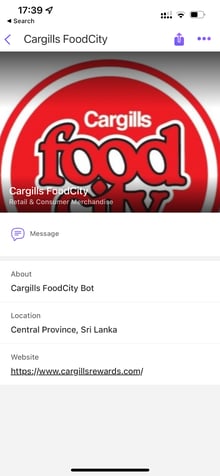
In January 2023, Viber launched a Business Inbox, which allows you to organize and filter messages from commercial businesses such as delivery services, stores, and banks.
The app’s mobile-focused features, such as a quick registration process, easy contact updates, one-tap calling, and integrated mission services, make it an excellent option for businesses looking to engage with customers on the go.
The Similarities of Global Social Platforms
Despite their critical differences, social media industries around the world have some fascinating similarities to that of the U.S.
For example, while many of North America’s most prominent social media apps are owned by Facebook or were created in Silicon Valley, most prominent global platforms were created by Tencent or other major tech firms based in China. Similarly, the two biggest Russian platforms are owned by the same company.
Although many of the apps above were created and launched in highly censored areas, they don’t seem to be falling behind on innovation due to those regulations.
Because international social platforms have evolved on a similar timeline as many common U.S. platforms, it seems like these geographies are building their own parallel social media industries, rather than just racing to create alternatives to our own platforms.
One thing major difference is that many of the examples on this list emphasize direct communication more than content.
Meanwhile, our own platforms emphasize content and user experience. While every social media platform we use today does have messenger with various features, only a few of them are or were ever standalone messengers.
For example, QZone and WeChat built their initial audiences as messenger apps and broadened their features from there. Meanwhile, Snapchat and WhatsApp are the only top platforms that started as direct messengers.
While Facebook Messenger is one of the most prominent text messaging platforms, it is an expansion of Facebook’s original News Feed-centered platform.
Going Global
If you’re interested in reaching international audiences, you should pay attention to the social media platforms they most commonly use, and what they use them for.
This will give you insight on what types of content these groups engage with, what motivates them, and what strategies could persuade buying decisions.
If you want to tap into an international audience, but can’t access some of the platforms on this list, you can alternatively consider testing out a campaign on a globally accessible platform like WhatsApp and WeChat.
![]()

![→ Free Download: Social Media Calendar Template [Access Now]](https://i4lead.com/wp-content/uploads/2023/04/3e56e15d-47bd-46c9-a256-99fde52abfe7.png)
